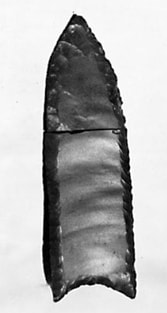The Soapstone Prairie Natural Area is in central Colorado, just south of the Wyoming border. It has within it an archeological site that few know about, even though it is very important to our understanding of man in the Americas. The Lindenmeier Folsom Site is one of the hidden gems of American Prehistory.
 point from the Lindenmeier Site, 1934
point from the Lindenmeier Site, 1934Folsom Man is named after the small town of Folsom, New Mexico, In 1908, a devastating flood unearthed bison bones that were exceedingly large. It wasn’t until 1925, when scientists finally investigated the site, that stone points were found with the bones. The bones were determined to be those of bison antiquus, an ancestor of the modern bison that had died out approximately 10,000 years ago.
 Bison Antiquus. They were 25-30% larger than present day bison.
Bison Antiquus. They were 25-30% larger than present day bison.The Folsom Site is just a kill site. It contains bones and stone points, but there is no evidence of habitation, no campfires, no other tools or implements. Although it proved that man was in the Americas much earlier than previously supposed, it shed little light on who these people were.
 |
| Working at the site with horses 1936 |
In 1924, three amateur archaeologists, A. Lynn Coffin, his father, Judge Claude C. Coffin, and their friend, C. K. Collins were wandering through a ranch owned by William Lindenmeier, Jr.. They were walking through an arroyo when they discovered some fluted points that were very different from the more abundant and smaller arrow points they usually found. The points were some fifteen feet below the surface. That depth suggested that they were very old. They called in the Judge’s brother, Major Roy G. Coffin, who persuaded Dr. Frank Roberts of the Smithsonian Institution to visit in 1934. The Smithsonian Institution, supported by the Colorado Museum of Natural History, excavated the site between 1935 and 1940. The Coffin brothers also did some excavating of their own.
 |
| The Coffins at the site 1935 |
The well-preserved site is buried under twelve to fifteen feet of sediment and covered by layers of silts and clays slowly deposited by floods and windstorms over thousands of years. It contains clusters of stone and bone debris, strewn over at least a half-mile. These clusters represent work areas, where Folsom peoples manufactured projectile points, repaired or discarded broken tools, cooked their food, cleaned and transformed animal hides into leather, and manufactured clothing.

The site is listed on the National Register of Historic Places and is designated a National Historic Landmark. Artifacts from the site are held by the Smithsonian Institution, the Denver Museum of Nature and Science, the Fort Collins Museum of Discovery, and in private collections.

https://fortcollinsimages.wordpress.com/2017/04/02/lindenmeier-a-folsom-man-site/
https://www.fcgov.com/naturalareas/finder/soapstone















